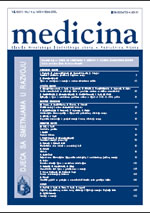
|
Medicina
Croatian Medical Association - Rijeka branch
ISSN: 0025-7729
Vol. 43, No. 2, 2007, pp. 118-122
|
 Bioline Code: me07016
Bioline Code: me07016
Full paper language: Croatian
Document type: Review Article
Document available free of charge
|
|
|
Medicina, Vol. 43, No. 2, 2007, pp. 118-122
| en |
Hepatitis C - Clinical Manifestations And Complications
Milić, Sandra & Mikolašević, Ivana
Abstract
HCV infection usually presents as an acute infection, chronic infection or as an extrahepatic manifestation. Acute infection is rarely recognized in clinical practice because the large majority of the patients are asymptomatic or develop symptoms which don’t attract clinical attention such as sickness, anorexy, anxiety and pain in the upper right quadrant of stomach, mialgy and
artralgy. Therefore, chronic hepatitis is diagnosed in a large majority of the patients after many years in case of large values of aminotransferasis during a routine laboratory check. A vast number of diseases are directly or indirectly connected with chronic hepatitis C. It is known for some of the extrahepatic manifestations to be firmly connected with hepatitis C while there is a doubt for others. Chronic hepatitis C is disease with no symptoms manifested for a long time or the symptoms are uncharacteristic, so it often becomes visible after development end-stage liver disease. It is considered that around 20% of the patients with the chronic type of the disease will develop cirrhosis within a period of 10 – 30 years with the possibility of developing hepatocellular
carcinoma in 1% – 5% of the cases per year. Furthemore, decompensation of liver cirrhosis and hepatocellular carcinoma are the leading indications for liver transplantation in patients with chronic hepatitis C.
Keywords
acute infection; chronic infection; extrahepatic manifestation; cirrhosis; hepatocellular carcinoma; liver transplantation
|
| |
| hr |
Hepatitis C - Klinička Slika I Komplikacije
Milić, Sandra & Mikolašević, Ivana
Infekcija hepatitis C virusom uobičajeno se prikazuje kao akutna infekcija, kronična infekcija, ili se očituje kao bolest izvan jetre. U kliničkoj praksi akutna se infekcija rijetko prepoznaje, budući da su u većine bolesnika simptomi asimptomatski, ili se razvijaju simptomi koji ne pobuđuju kliničku pozornost, poput mučnine, anoreksije, nelagode ili bolnosti u gornjem desnom kvadrantu trbuha,
mialgije i atralgije. Stoga se u većine bolesnika kronični hepatitis dijagnosticira nakon više godina, kada se tijekom rutinske laboratorijske obrade ustanove povišene vrijednosti aminotransferaza. To je u skladu s činjenicom da se u 80% bolesnika inficiranih hepatitis C virusom, razvije kronični hepatitis. Niz je bolesti izravno ili neizravno povezano s kroničnim hepatitisom C. Dok se za pojedine pokazatelje bolesti izvan jetre zna da su združeni s kroničnim hepatitisom C, za druge postoji tek sumnja. Kronični hepatitis C podmukla je bolest koja je tijekom dugotrajna razdoblja bez simptoma, ili simptomi nisu karakteristični, stoga često postaje uočljivom tek kada se razviju komplikacije kronične jetrene bolesti. Smatra se da će 20% bolesnika s kroničnim hepatitisom C u razdoblju od 10 do 30 godina razviti cirozu jetre, uz mogući razvoj hepatocelularnoga karcinoma u 1% – 5% slučajeva tijekom godine dana. Dekompenzacija jetre i hepatocelularni karcinom u bolesnika s kroničnim hepatitisom C, danas su vodeći pokazatelji za transplantaciju jetre.
akutna infekcija; kronična infekcija; pokazatelji bolesti izvan jetre; ciroza; hepatocelularni karcinom; transplantacija jetre
|
| |
© © 2007 - Croatian Medical Association - Rijeka branch
Alternative site location: http://hrcak.srce.hr/medicina
|
|
